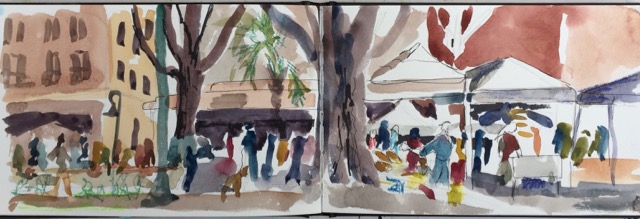
Popcorn’s Ready
5.5 x 17 inches
Watercolor on Strathmore Watercolor book
©2017 Lucinda Howe
Not for Sale
If you haven’t painted outdoors (“en plein air”), you might be hesitant to meet up with a group of painters and get started. I encourage you to join in the fun.
On Saturday morning, I joined the About Face group at Soda City market in Columbia, South Carolina. I was running late, so I had only an hour to work before critique and lunch. The market was busy, so I knew I couldn’t capture a lot of detail. I decided to work small in a watercolor book. I sat on the low wall at Boyd Plaza near the Kettle Corn tent. The man rang the bell every time the popcorn was ready. Although you see only the painting, I remember the ringing of the bell, the smell of the popcorn, and the movement of the people, dogs, and strollers. For me, the best part of painting in a busy environment like Soda City is the memories of the sensations I experienced while painting.
If you would like to try outdoor painting, here are 6 tips to get you started….
- Supplies- Pack your kit with easel, paints, supports, brushes, tools, bug spray and sunscreen. When I started plein air painting, I would go out in my back yard and paint, and I always forgot something. I’d go back into the house to get the paper towels, then I’d go back for the bug spray, then the kneaded eraser, until I finally had everything I needed. Then I made a checklist to be sure I had the essentials when I ventured out with a group.
- Scouting – When you arrive at the site, scout around. Look at the angle of the sun, take photos, think about composition before you select your spot.
- Shade – It’s important to be in the shade for the sake of your skin. Also, your canvas should be in the shade or the painting will be too dark when you take it inside.
- Small Supports – Sketchbooks, small panels and canvases require minimal paint and can be completed in a couple of hours. It’s more satisfying to complete most of the piece on site than to just get started before time to quit. Painting small also forces you to narrow your focus and simplify your composition. Save the large canvases until you have more experience.
- Senses – Outdoor painting is not just about what you see. Observe the smells, tastes, sounds, and feelings that surround you as you paint.
- Sharing – Be sure to share your drawing or painting with others. You’ll learn from group critique, but you will also be able to share your unique view of the experience with others. I’m always amazed at how all the artists have different perspectives on similar subject matter. Isn’t that what visual communication is all about?
As we move into spring, there will be more opportunities to paint with plein air groups and to pack your art supplies for vacation travels. If you would like more information about painting with a group around Columbia, SC, contact me. If you don’t paint here, paint somewhere!